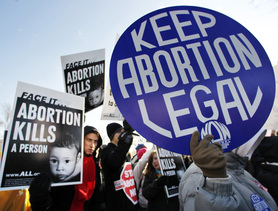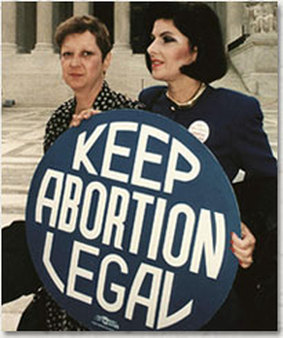Jane RoeNorma L. McCorvey or "Jane Roe" (her name was changed to protect her identity) grew up in a broken home. She dropped out of high school when she was only 14, and two years later she became married to Woody McCorvey who later abused her so she left him and moved in with her mother while remaining in Texas. In June 1969, at the age of 21, she discovered that she was pregnant with her third child, and she did not want to have the baby at all. Since the Texas law prohibited most abortions, she felt that it "violated her constitutional rights" and her "right to privacy". She could not afford to travel out of state for the procedure, and she wanted to have it in a safe environment nearby. Her friends convinced her to falsely report that she was raped, but due to lack of documentation and police reports, her accusation was revoked.
|
In 1970, Roe took action with her two attorneys, Linda Coffee and Sarah Weddington, and filed a lawsuit against Henry Wade, a Dallas Country District Attorney who believed that abortion should remain illegal, in a Texas Federal Court in attempt to legalize abortion for her own selfish ambition. During this time period, Jane gave birth to her child, but thankfully she gave the her up for adoption. I think that was the best thing for the child because the baby needed to grow up in a stable home. The Supreme Court said that the Texas law restricting abortion went against the Constitution, and her case was continued through 1971-1972. Today, Roe vs. Wade remains one of the most intensely debated Supreme Court case.
Change of HeartLater in the 1980's, Jane Roe attempted to dig herself out of the hole she previously created. She admitted that she only wanted an abortion because of her unemployment and her unhappiness due to her rough life. She revealed that her two attorneys Linda and Sarah were looking for a plaintiff to help them fight the Texas law against abortion, and she felt pressured to take the role. As shown in this video, Jane Roe regrets fighting for legal abortion. In mid-1990, she converted to a Christian and participates in pro-life movements to help prevent abortion. This whole tragedy only proves that people need to think ahead before making huge decisions like this so that they will know ahead of time if it is the best thing to do.
|
|
Right to Privacy

After almost two years of hearing evidence, the Court announced a final 7-2 vote and agreed that the Texas law violated her right to privacy. The 1st, 4th, 9th, and 14th Constitutional Amendment declares that each person has a "zone of privacy." This means that a person's privacy is protected from any state law concerning marriage and child rearing activities. The Court announced that the "zone of privacy" was broad enough to include abortion due to the amount of stress and emotional baggage the mother would carry. I think that the mother would not carry this "baggage" if she simply did not have an abortion in the first place. Finally, the end results of the case was that any state law concerning abortion would be restricted.
Prenatal LifeThe Supreme Court began to argue that a fetus was not defined as a "person", and only sometimes did the U.S. Constitution regard a fetus to be a person that deserved protection. This helped Roe justify and pass her case because she believed that a fetus did not have any rights. The medical community ruled out that a fetus might be "viable" (capable of meaningful life) only after 6 months of birth. As a result, the decision for a mother to abort her baby was something that needed to be discussed between her and her doctor. A baby should not be considered a "human" only after birth. Life begins once the fertilization process is over, and a beautiful human being is formed. Ultra sounds prove that pregnant women carry a moving, breathing, and an alive baby within them. How could that NOT be considered a human?
|


